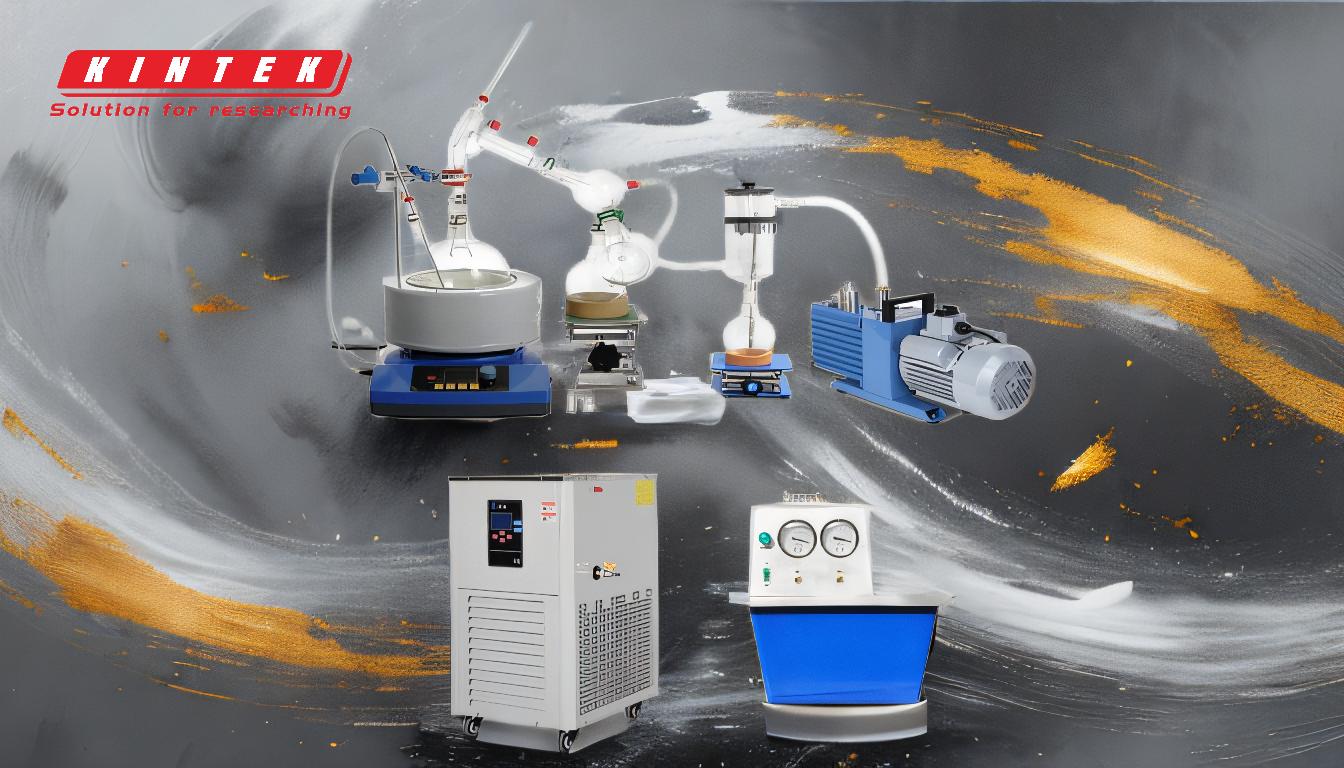Short path distillation under vacuum is a specialized separation technique used to purify or isolate components of a mixture based on their boiling points. It operates under reduced pressure (vacuum), which lowers the boiling points of the substances, allowing for the distillation of heat-sensitive or high-boiling-point materials. The process involves heating the mixture in a flask, evaporating the components, and condensing them over a short distance into separate collection flasks. This method is highly efficient, minimizes thermal degradation, and is ideal for laboratory-scale applications requiring precise separation of compounds.
Key Points Explained:

-
Basic Principle of Short Path Distillation:
- Short path distillation relies on the principle of separating components based on their boiling points under reduced pressure.
- The vacuum lowers the atmospheric pressure, reducing the boiling points of the substances, which prevents thermal degradation and allows for the distillation of heat-sensitive materials.
-
Key Components of the Apparatus:
- Feed Vessel: Holds the extraction material before it is transferred to the heating flask.
- Heating Flask: Contains the mixture and is placed in a heating mantle to gradually increase the temperature.
- Fractionating Tube: A short tube where vapors travel, cool, and condense.
- Vacuum System: Creates a low-pressure environment to facilitate evaporation at lower temperatures.
- Condensing Unit: Cools the vapors, converting them back into liquid form.
- Receiving Flasks: Collect the separated fractions based on their weight or boiling points.
-
Process Steps:
- Heating: The mixture in the heating flask is gradually heated to preset temperatures, causing specific components to evaporate.
- Evaporation: Under vacuum, the vapors travel a short distance (a few centimeters) into the fractionating tube.
- Condensation: The vapors are cooled in the condensing unit, often using a recirculating chiller, and converted back into liquid form.
- Collection: The condensed liquids are collected in separate receiving flasks based on their weight or boiling points.
-
Advantages of Short Path Distillation:
- Efficiency: The short distance between evaporation and condensation minimizes distillate loss and ensures high purity.
- Low Thermal Degradation: The reduced boiling points under vacuum prevent the decomposition of heat-sensitive compounds.
- Compact Design: The apparatus has a small footprint, making it suitable for laboratory-scale applications.
- Repeatability: The process can be repeated multiple times to achieve optimal separation and refinement.
-
Applications:
- Pharmaceuticals: Purification of active pharmaceutical ingredients (APIs) and other heat-sensitive compounds.
- Essential Oils: Isolation of volatile compounds from plant extracts.
- Cannabis Industry: Separation and refinement of cannabinoids and terpenes.
- Chemical Research: Isolation of high-boiling-point or thermally unstable compounds.
-
Comparison with Other Distillation Methods:
- Fractional Distillation: Operates at atmospheric pressure and is suitable for separating components with closer boiling points but may not be ideal for heat-sensitive materials.
- Steam Distillation: Uses steam to separate volatile compounds but is less precise than short path distillation.
- Molecular Distillation: Similar to short path distillation but operates at even lower pressures and is used for extremely heat-sensitive materials.
-
Considerations for Equipment Purchasers:
- Vacuum System Quality: Ensure the vacuum pump can achieve and maintain the required pressure levels.
- Heating Mantle Precision: Look for a heating mantle with precise temperature control to avoid overheating.
- Condensing Efficiency: A high-performance condensing unit with a recirculating chiller is essential for effective condensation.
- Material Compatibility: Ensure all components are made of materials compatible with the substances being distilled (e.g., glass, stainless steel).
- Scalability: Consider whether the system can be scaled up for larger batches if needed.
By understanding these key points, purchasers can make informed decisions about the equipment and consumables required for short path distillation under vacuum, ensuring optimal performance and results.
Summary Table:
| Aspect | Details |
|---|---|
| Principle | Separates components based on boiling points under reduced pressure. |
| Key Components | Feed vessel, heating flask, fractionating tube, vacuum system, condensing unit, receiving flasks. |
| Process Steps | Heating → Evaporation → Condensation → Collection. |
| Advantages | High efficiency, low thermal degradation, compact design, repeatability. |
| Applications | Pharmaceuticals, essential oils, cannabis industry, chemical research. |
| Comparison | More precise than fractional or steam distillation; ideal for heat-sensitive materials. |
| Equipment Considerations | Vacuum system quality, heating mantle precision, condensing efficiency, material compatibility, scalability. |
Ready to optimize your lab’s separation process? Contact us today to learn more about short path distillation under vacuum!












